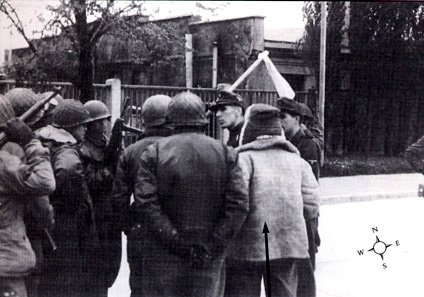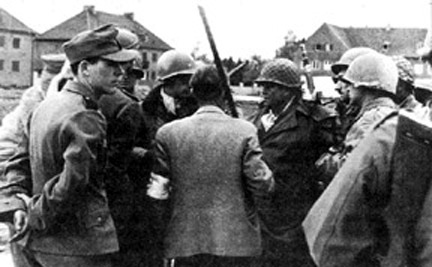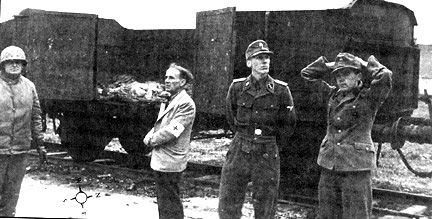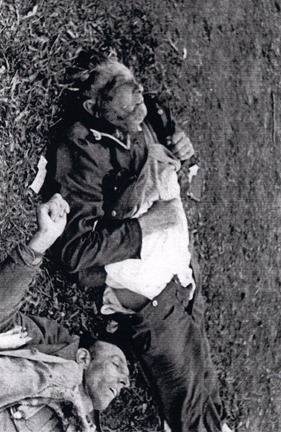Surrender of the Dachau camp"The crimes done behind the walls of the worst of all Nazi Concentration Camps, now live only to haunt the memories of the Rainbow men who tore open its gates and first saw its misery, and to accuse its SS Keepers of one of the worst crimes in all history. When Infantrymen of the Rainbow fought their way into Dachau, against fanatical SS Troops who met deserved violent deaths along the moats, behind the high fences, and the rail yards littered with the bodies of fifty carloads of starved victims, these hardened soldiers expected to see horrible sights. But no human imagination fed with fantastic tales that have leaked out from this earliest and most notorious of all Nazi Concentration camps, could have been preparation for what they did see there...." T-3 James Creasman, HQ Company, 42nd Infantry Division, 1 May 1945  The photograph above shows the surrender of the Dachau prison compound by 2nd Lt. Heinrich Wicker to Brigadier General Henning Linden, Assistant Division Commander of the 42nd Infantry Rainbow Division of the US Seventh Army on April 29, 1945. Wicker is the second man from the right, wearing a cap; the man on the far right is his aide. Brig. Gen. Linden is the second man from the left, wearing netting on his helmet; he is standing with his hand on his hip. The arrow points to Marguerite Higgins, a newspaper war correspondent, who is wearing a jacket with a hood. Victor Maurer, a Red Cross representative who accompanied 2nd Lt. Wicker, carrying a white flag, is hidden behind one of the American soldiers in the photo. In the background, one can see the buildings in the SS Training Camp which was right next to the Dachau prison compound. This picture was taken near the southwest corner of the SS camp. The prison compound was east of this location, through the main entrance and then through the gatehouse with a sign that read "Arbeit Macht Frei."  In the photograph above, Victor Maurer is standing with his back to the camera, holding a stick with a white flag on top of it. Brig. Gen. Linden is standing to the right of Maurer and Wicker is hidden behind his aide, who is in the left foreground. The buildings in the background are SS barracks. In his report to Headquarters, written on 2 May 1945, Brig. Gen Linden wrote the following: As we approached the Southwest corner, three people came forward with a flag of truce. They were a Swiss Red Cross representative, Victor Maurer, and two SS troopers who said they were the camp commander [SS Lieutenant Wickert] and his assistant. They had come here on the night of the 28th to take over from the regular personnel, for the purpose of surrendering the camp to the advancing Americans. The Swiss Red Cross representative said there were about one hundred SS guards in the camp who had their arms stacked, except for the people in the tower...He had given instructions that there were no shots to be fired, and that it would take 50 men to relieve the guards, as there were 42,000 "half-crazed" inmates, many of them typhus-infected.... Note that Brig. Gen. Linden incorrectly referred to Wicker as Wickert. Maurer had arrived at the Dachau camp on April 27, 1945 with 5 truckloads of food for the prisoners. Just the day before, on April 26th, Dachau Commandant Wilhelm Eduard Weiter had left the camp with a transport of prisoners headed south. The telephone lines were down, due to Allied bombing, and the Commandant had not been able to communicate with headquarters in Oranienburg. On his own authority, acting Commandant Martin Gottfried Weiss had given Maurer permission to enter the camp and distribute the food; Maurer was allowed to spend the night in Room 3 of Barrack 203 in the SS garrison, right next to the concentration camp. The following quote is from the official report that Maurer filed after the liberation, as quoted by Marcus J. Smith in his book "The Harrowing of Hell": During the night (of April 28th) there was a loud uproar on account of the closeness of the battle. Also, in nearby barracks, many SS soldiers were probably getting ready to fight, or had been given other tasks to accomplish. But I only learned that on Sunday morning (April 29th). The atmosphere was strange: wherever one looked there were signs that made you think that the troops that had been in the barracks had fled. Furthermore, the roar of battle was closer. Arriving at the front gate about 10:30 a.m. (on April 29th), I met the soldiers who were guarding the camp; a white flag now floated from one of the principal towers. Most of the officers, soldiers and employees had left the camp during the night. On the day of the liberation, 2nd Lt. Heinrich Wicker was in charge of a group of SS men called "Kampfgrüppe Süd" (Combat Group South), a unit formed from concentration camp guards who had formerly served at Neckarelz, Kochendorf and Hessental, which were all sub-camps of Natzweiler-Struthof. The group, which had only recently arrived at Dachau, consisted of around 100 to 150 men. According to 1st Lt. William Cowling, who was with Brig. Gen. Linden, the 42nd Division had been advancing down a road toward Munich when, by chance, they heard about the Dachau concentration camp. In a letter to his family back home, written on April 30, 1945, Cowling wrote: Enroute we learned from civilians and two newspaper people that just off the main road was a concentration camp of Dachau, oldest largest and most notorious camp in Germany. These newspaper people were going up to see the camp so we decided to go up too. We ride in a Jeep with a guard out ahead of the boys and we were several hundred yards ahead as we approached the Camp. The first thing we came to was a railroad track leading out of the Camp with a lot of open box cars on it. As we crossed the track and looked back into the cars the most horrible sight I have ever seen (up to that time) met my eyes. The cars were loaded with dead bodies. Most of them were naked and all of them skin and bones. Honest their legs and arms were only a couple of inches around and they had no buttocks at all. Many of the bodies had bullet holes in the back of their heads. It made us sick at our stomach and so mad we could do nothing but clinch our fists. I couldn't even talk. We then moved on towards the Camp and my Jeep was still several hundred yards ahead. As we approached the main gate a German officer and a civilian wearing an International Red Cross band and carrying a white flag came out. We immediately filed out and I was just hoping he would make a funny move so I could hit the trigger of my tommy gun. He didn't however, and when he arrived abreast of us he asked for an American officer. I informed him he a was talking to one and he said he wished to surrender the camp to me. The man who wished to surrender Dachau to the Americans was 2nd Lt. Heinrich Wicker. In his official report on the liberation of Dachau, Maurer wrote the following, as quoted by Smith in his book: I remained with a German lieutenant until the camp was delivered to the Americans. He and his soldiers had intended to abandon this large camp containing 35 to 40,000 prisoners, and it was only after lengthy negotiations that I persuaded him to change his mind, but with the following conditions: 1. Sentries should remain in the towers in order to keep the prisoners under control, to prevent them from escaping. 2. The soldiers who were not on guard were to remain in the courtyard, unarmed. 3. A guarantee should be made that the remaining members of the German garrison would be allowed to retreat to their own battle line. These conditions were most happily accepted, for otherwise there would have been a catastrophe: if the thousands of prisoners, motivated by their desire for vengeance, had been allowed to escape, the people in the bordering regions would have suffered; it was impossible to predict the damage that might have resulted from the epidemic. The sound of the battle became unbearable, and I noticed that the fighting was now in front of the gate. I then decided to take the following action: I found a broomstick and hung a white towel from it. I asked a German officer to accompany me, and we walked through the main gate. The bullets whistled about us. A little later, I saw an American motorized column which I attracted by waving the white flag. Soon we were surrounded by American military vehicles. I introduced myself. At first, the American general (Brig. Gen. Henning Linden) asked me to have the German officer take photographs of a train filled with cadavers. As I learned later, the train had arrived from Buchenwald; within it were 500 cadavers. In my opinion, many of them had been killed, others died of hunger. Note that Victor Maurer estimated that there were 500 bodies on the train; the American liberators counted 2,130 bodies. American soldiers didn't normally carry cameras with them, but apparently Wicker or his aide had a camera and the first order of business was to document the crimes of the Nazis. Wicker, who had only recently arrived in the camp, claimed to have had no prior knowledge of the train, according to Brig Gen. Linden's account of the surrender. The bodies on the train was the first thing that was brought up at the proceedings of an American Military Tribunal against the Dachau staff in November 1945. None of the prosecution witnesses knew any of the details, so this charge was dropped, but later Hans Merbach, the SS officer from Buchenwald who was in charge of the train, was convicted as a war criminal and hanged in 1947. The photograph below shows Victor Maurer wearing a white arm band and standing next to 2nd Lt. Wicker, after they complied with Brig. Gen. Linden's request for a photo opportunity beside the "Death Train." Wicker's aide is on the right with his hands on his head.  The train was standing on the tracks on the west side of the SS camp; the concentration camp was on the east side of the Dachau complex. The train had arrived on April 26th or 27th, according to varying accounts. It was carrying prisoners who had been evacuated from the Buchenwald concentration camp on April 7th; the train had been delayed because Allied planes had bombed the tracks and strafed the train, killing the prisoners riding in open gondola cars. After the visit to the train, Maurer's account continues as follows: I then met Major Every (Major Herman L. Avery, of the 42nd Division), and I told him about the plan to turn the camp over to the Americans, and I asked him to transmit this information to the General (Linden). As told to his family, in his letter of April 30th, 1st Lt. Cowling's story of the surrender continues as follows: "About that time the General (Brig. Gen. Linden) arrived and got the story from the German Lieutenant (that the Camp was still manned by German Guards who were armed but had orders not to shoot at us but only to keep the prisoners in check.) Well about that time somebody started shooting from over on our left flank and we ducked but made the Germans stand in front of us. Finally the fire let up and we sent one of the guards back for a company of infantry. The newspaper people said they were going on into Camp and I got permission to go on with them with my guard leaving the others with the General. We went through one gate and spotted some Germans in a tower. I hollered in German for them to come to me and they did. I sent them back to the guards and General and got on the front of the newspaper people's Jeep and headed for the gate. Victor Maurer's account continues, as quoted by Marcus J. Smith in his book: We reentered the prison courtyard in the Major's vehicle; by this time some Americans were there. Thousands of prisoners were beside themselves with the joy of freedom. The guards in the towers had already been replaced by Americans. In a small exterior courtyard, a few shots were still being fired; some soldiers were killed on both sides. I personally contacted the American general and told him about the plan to deliver the camp, and received his consent. Col. Howard Buechner wrote in his book "The Hour of the Avenger" that 30 SS soldiers were "killed in combat," but he did not mention that any American soldiers were killed or wounded at Dachau. Buechner was the medical officer with the 45th Thunderbird Division which participated in the liberation of Dachau. Lt. William Cowling is generally credited with being the first American soldier to enter the prison enclosure at Dachau. In the letter to his parents, Lt. Cowling described what happened: We went through one gate and spotted some Germans in a tower. I hollered in German for them to come to me and they did. I sent them back to the guards and General and got on the front of the newspaper people's Jeep and headed for the gate. A man lay dead just in front of the gate. A bullet through his head. One of the Germans we had taken lifted him out of the way and we dismounted and went through the gate into a large cement square about 800 squares surrounded by low black barracks and the whole works enclosed by barbed wire. When we entered the gate not a soul was in sight. Then suddenly people (few could call them that) came from all directions. They were dirty, starved skeletons with torn tattered clothes and they screamed and hollered and cried. They ran up and grabbed us. Myself and the newspaper people and kissed our hands, our feet and all of them tried to touch us. They grabbed us and tossed us into the air screaming at the top of their lungs. I finally managed to pull myself free and get to the gate and shut it so they could not get out. Then I felt something brush my shoulder and I turned to the left of the two block house guarding the gate to find a white flag fluttering square in my face and on the end of it inside the house eight Germans. I looked around the house and entered. I got the same question, are you an American Officer and said Yes. They turned over their arms, pistols and rifles to me and I told them to sit tight. I then went back outside and sent my driver to get the Jeep. Then I went back into the Germans and took their arms and sent the pistols to my Jeep (I gave all away but two). When I came back out the General was there and the people inside the enclosure were all in the large square shouting and crying. Then a terrible thing happened. Some of them in their frenzy charged the barbed wire fence to get out and embrace us and touch us. Immediately they were killed by an electric charge running through the fence. I personally saw three die that way. Our troops arrived about that time and took the rest of the guards, Germans (who during all this time had remained in the towers around the prison.) A number of them and I sincerely regret that I took the eight prisoners that I did after a trip through Camp which I shall describe in a minute. In his official report to Headquarters, Lt. Cowling wrote the following about what happened next: General Linden directed his guards to get all the people back inside the enclosure. At about this time, Colonel Fellenz, of the 1st Battalion, 222nd Regiment, arrived with some of his men. There were also some men of the 45th Division present. German guards still remained in all of the towers surrounding the prison with the exception of the one previously mentioned, and the two right at the gate. As Colonel Fellenz's men and some of the 45th Division approached, some of the [SS] guards fired at some of the prisoners who were trying to break through the fence. The doughboys of the two divisions shot the SS guards who had commenced firing and quickly rounded up the others from the rest of the towers... One of the men with the 222nd Regiment of the 42nd Rainbow Division was Ignacio Inclan Perez, a 17-year-old Mexican-American soldier from Cotulla, Texas. Gabriel Perez recalls that his father talked about seeing the train at Dachau just before entering the camp. In an e-mail to me, Gabriel wrote, "I also remember my father telling me about a German soldier that he shot and killed as he was trying to get away. He also mentioned that he saw German guards in a mess area that had been gunned down by American soldiers. He stated that he was glad he never did that because it would have been difficult to live with later in life." Lt. Col. Walter J. Fellenz, an officer in the 222nd Regiment, gave the following information in his account of the liberation of Dachau: Amid the deafening roar of cheers, several inmates warned us of danger by pointing to one of the eight towers which surrounded the electrically charged fence. The tower was still manned by SS guards! Half crazed at what we had just seen, we rushed the tower with rifles blazing. The SS tried to train their machine guns on us, but we quickly killed them each time a new man attempted to fire the guns. We killed at least 17 SS, then in mad fury our soldiers dragged the dead bodies from the towers and emptied their rifles into the dead SS chests. Lt. Col. Felix Sparks of the 45th Thunderbird Division disputed this account; he said that his men had shot the guards in the towers with rifles from the cover of the many buildings surrounding the confinement area. Captain Leland L. Loy, the Chaplain of the 3rd Battalion of the 157th Infantry Regiment of the 45th Thunderbird Division, gave the following account of what happened after the concentration camp had been surrendered to the 42nd Division, as quoted by Col. Howard Buechner in his book "The Hour of the Avenger": We had quite a time getting the prisoners back into the stockade for they had fanned out in every direction. Sometime during this period a German Guard came running toward us. We grabbed him and were standing there talking to him when a 42nd Division man (the only one I saw in the camp) came up with a tommy-gun. He grabbed the prisoner, whirled him around and said, "There you are you __ __ __ __!! The man was only about three feet from us, but the soldier cut him down with his sub-machine gun. I shouted at him, "what did you do that for, he was a prisoner?". He looked at me and screamed "Gotta kill em, gotta kill em." When I saw the look in his eyes and the machine gun waving in the air, I said to my men, "Let him go." The photograph below shows the bodies of two men who were killed during the liberation of Dachau. The man shown at the top of the photo is wearing an SS uniform; his trousers have been pulled down, and possibly his body was mutilated. The second photograph below shows the same two men, taken before the bodies were disturbed.   Maurer wrote in his report that it was not until 10 p.m. that night that the camp had "calmed down." He also stated that "many shots were still heard that night." At that time the prisoners were still locked inside the concentration camp; Maurer wrote in his report that he slept in the Commandant's room in the SS garrison. He mentioned in his report that his trunks had been forced open and that many things were missing including the sum of 200 French sous. Maurer spent two more days at Dachau; he wrote in his report that he returned to his room in the afternoon of the next day. "Unhappily I must report that I had been robbed a second time." If Maurer knew that the Waffen-SS soldiers stationed in the SS garrison had not been allowed to retreat to their own battle line, as agreed upon in the terms of the surrender, he did not mention it in his report. Nor did he mention what happened to 2nd Lt. Heinrich Wicker after he had surrendered the concentration camp. Arthur Haulot, a Belgian political prisoner in the camp, wrote the following in his diary regarding the events of April 29, 1945: The SS-officers are executed the same afternoon. At night the soldiers suffer the same fate. The Americans say: "Since we saw the first camp, we have known. We understood that we were not engaged in war against soldiers and officers, but against criminals. We treat them like criminals." In a diary entry, dated May 2, 1945 Arthur Haulot wrote that the Americans continued to kill the SS soldiers days after the surrender of the camp. It is clear that the liberators shoot
down anyone wearing an SS-uniform without mercy. ContinueMore about 2nd Lt. WickerExecution of Waffen-SS soldiersThe killing of the Guards in Tower BBack to Liberation of DachauBack to Table of ContentsHomeThis page was last updated on November 7, 2007 |